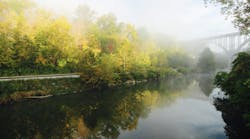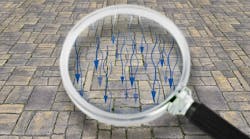About the author: David Aquilina is a consultant and freelance writer. Aquilina can be reached at [email protected].
No detail was overlooked in the $485 million renovation and reconstruction of Kyle Field, the football stadium on the campus of Texas A&M University in College Station, Texas. These details include the 25,000-sq-ft track surrounding the playing field.
“The track provides drainage for the field and supplemental drainage for the lower seating bowl. It had to be permeable and integrated with the main sub-surface drainage system installed under the field,” said David Steger, assistant project engineer for Manhattan-Vaughn, the general contractor for the redevelopment of Kyle Field. “The material selected for the track also had to be smooth and safe for players sliding out of bounds and onto the track.”
“In addition to smoothness for player safety and permeability to drain the track quickly so the surface does not get slick, the traditions of Texas A&M football made strength and durability essential attributes for the track,” said Dave Frazier, engineering sales manager for GeoSolutions Inc., a regional provider of engineered solutions for soil stabilization, erosion control, drainage and low impact development. Everyone who has attended a home game for the Texas A&M Aggies has witnessed the pageantry of the Corps of Cadets March-In. The 300-member Fightin’ Texas Aggie Band leads the march of the entire 2,450-member Corps of Cadets into and around Kyle Field. The March-In features the Parsons Mounted Cavalry on horseback with the Spirit of ’02 cannon, a 1902 model 3-in. U.S. Army field gun, which is fired after every Aggies touchdown. The track had to be resilient enough to stand up to the rigors of the March-In.
The track had to be able to stand up to the university's traditions and remain safe for its athletes.
Selecting a Solution
According to Steger, the project team debated the pros and cons of alternative solutions for the track’s surface. Porous asphalt was deemed too expensive and too rough. A rubber equine mat would have been smooth enough, but would have required installation atop a base of 2 in. of concrete, making it impervious, not permeable.
Manhattan-Vaughn suggested consideration of Porous Pave XL, which GeoSolutions had introduced to them. It is a pour-in-place permeable paving material that consists of 50% recycled rubber chips and 50% chipped granite aggregate mixed with a moisture-cured liquid binder.
An eco-friendly green building product manufactured in the U.S., Porous Pave is a heavy-duty material engineered with up to 29% void space to allow water to permeate its surface and filter down through the aggregate base on which it is installed at a tested rate of 5,800 to 6,300 gal per hour per square foot. “Water passes right through the surface, leaving no puddles of rainwater on the track,” said Dave Ouwinga, president of Porous Pave Inc. “The recycled rubber content makes it slip-resistant, which increases safety for the March-In.”
Changing the Mix
Frazier and GeoSolutions poured a 12-by-12-ft test installation for inspection by the project team, including the project architect and the Texas A&M athletic department. The traditional product mix that was used for the test includes 1/4- to 3/8-in. nominal-sized recycled rubber chips manufactured via the controlled shredding and processing of discarded tires. In terms of functionality, permeability, strength and durability, the project team was satisfied. However, the athletic department was concerned that the permeable paved surface would be too rough for player safety.
GeoSolutions and the manufacturer suggested trying the company’s new 1/8- to 1/4-in. fine-cut rubber chips. The smaller rubber chips provide a smoother paved surface.
DecoCrete Inc., the contractor selected for the track surfacing project, installed a final test area with the new formulation. It passed muster with the athletic department.
Challenges & Results
The installation was done in July and August 2015, with daytime temperatures topping 100 F. Therefore, the work was performed at night.
“It was just too hot during the day,” said Rafe Gibson, CEO of DecoCrete Inc. “For the safety of the crew, we had to do the work during the nighttime hours.”
Gibson’s crew of 13 to 15 people typically started at 7 p.m. and worked until anywhere from 1 to 3 a.m. The job took 14 nights.
They installed and then compacted an aggregate base of #57 stone atop the field sub-surface drainage. The minimum depth of the base is 12 in. The crew then mixed batches of the permeable paving material in a standard mortar mixer and poured the mix in place one section at a time at a depth of 1.5 in. They smoothed it out with bull floats and finished the edges with hand trowels.
“The field maintenance staff was cutting and watering the new grass field daily. Porous Pave is moisture cured, so we needed the surface to be dry,” Gibson said. “We coordinated our efforts so that sections of the field where we would be working in the evening were watered during the day before and therefore dry when we started. The surface was cured by morning so they could continue their watering.”
The color of the installed product is determined by the color of the rubber chips in the mix. The manufacturing process infuses the chips with dyes and ultraviolet inhibitors. The standard green color was selected for Kyle Field. The rubber chips incorporated into the product are processed from recycled scrap tires. By using Porous Pave, Texas A&M diverted approximately 5,625 tires from U.S. landfills.


